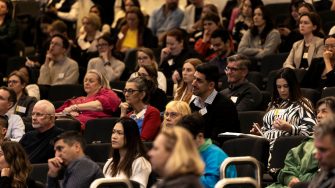NDARC blog
Reflections on the 2024 NDARC Annual Research Symposium
Reflections on the 2024 NDARC Annual Research Symposium

The 2024 NDARC Annual Research Symposium – the Centre’s premier event – was held on 20 September and featured leading national and international researchers in the alcohol and other drugs (AOD) sector. The event showcased the latest in research and drug trends, their implications for clinicians, support workers and policymakers, and an overview of things to come.
The themes of this year’s Symposium—'Opioids’, ‘New, Novel, and Trending’, and ‘Alcohol’—and the accompanying program were chosen by the Scientific Program Committee, led by Chair Dr Peter Gates and Co-Chair Dr Ria Hopkins. Here, the pair reflect on their experience in organising the event and highlights from the Symposium.
Dr Peter Gates:
It was my pleasure to chair the Scientific Program Committee (SPC) for the 2024 NDARC Annual Research Symposium. The very tight program came together early this year, and it was a testament to NDARC staff that our call for abstracts was met by more than 50 submissions. The SPC convened to review the submissions and find our session themes in June. Our first theme was obvious as NDARC has clearly conducted a substantial amount of work to address opioid use, including opioid agonist treatments and opioid use disorder, much of this under the acclaimed leadership of Scientia Professor Louisa Degenhardt. The breadth of submissions filled the program easily, and our other themes came to the fore, ensuring there was something there for everyone.
With our usual Symposium home in the UNSW campus booked for the selected date, we ventured outward for the first time. I feel that most would agree that the Wesley Conference Centre was an excellent replacement, with stadium-like seating, multiple huge breakout rooms, and room for catering. Not to mention the polite and professional audio visual (AV) staff. Full credit must go to the NDARC Communications Team who worked so well with the venue staff, leading to an almost seamless day. My thanks must also go to our brilliant session chairs for what might be the first year with all accepting the offer, and all showing up on the day. Then - with the catering, transport and welcome to Country established - full focus came to the presentations.
Over the course of the day were 29 presentations and 24 posters. A staple now at the NDARC Symposium, my highlight for the day was the Spotlight session, where it was demonstrated that one can learn so much about a project that can span a full year but be so professionally condensed to a single slide and three-minute presentation. I’m sure many also noted the honour of including a knighted scholar in the line up with Professor Sir John Strang from King’s College London, who—among a plethora of achievements—was involved in the initial roll out of naloxone in the 90s but spoke about a much more recent multi-centre randomised trial of new supervised heroin treatment.
I was personally unprepared for the extent of work that goes into planning and organising the Symposium and would like to take the opportunity to thank the NDARC professional staff who worked so hard to make the day a success. I feel that the event was well received with this evidenced in emails from clinicians, policy makers, health promotion staff, and other affiliated research centres.
Dr Ria Hopkins:
It was my honour to serve as the Co-Chair the SPC for the 2024 NDARC Symposium. This year’s event, held at the Wesley Conference Centre in Sydney, featured talks from some of the most preeminent researchers in our field, including Professors Sir John Strang, Jurgen Rehm, and Matthew Hickman. We also heard from NDARC’s own experts including Scientia Professor Louisa Degenhardt and Professor Shane Darke, with the latter giving his final Symposium keynote address before his well-earned retirement (this being his 36th Symposium - what a legend!).
We were treated to talks and spotlight presentations from some of NDARC’s up-and-coming Early Career Researchers, and excitement was palpable around the 24 posters on display. Overall, I was taken aback by not just the quality of work, but also the breadth of topics discussed across problems both old (e.g., heroin, alcohol) and emerging (e.g., nitazenes, vaping), and everything in between. It can be easy in this field to get caught up in the problems, so it was wonderful to see so many solutions-based presentations, from studies about established therapies such as opioid agonist therapy, to programs co-designed with affected communities and people with lived experience. If you missed a session or couldn’t make it on the day, I highly recommend checking out the recordings on the NDARC website.
In addition to giving NDARC a platform to showcase our researchers, the Symposium is always a fantastic way to meet people working in the field, to network and catch up with friends old and new, and to spark ideas for future projects and collaborations. Our attendees joined us both in person and online from a wide range of disciplines and organisations, including clinical care, research, community, government, and peer-based groups.
It was wonderful to end the day with a performance from the Choir of Hard Knocks, whose personal experiences and heartfelt performance led to more than a few misty eyes in the audience (mine included).
In this Co-Chair’s humble opinion, the day was a wild success. I’d like to thank everyone involved behind the scenes, as well as all of the speakers, chairs, and attendees. Special shout outs to the NDARC Operations and Communications Teams, and to our SPC Chair, Dr Peter Gates. We have our work cut out for us trying to top this, and hope you’ll join us next year!